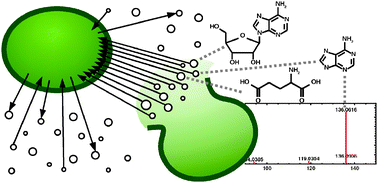Cyanobacteria are important primary producers in diverse ecosystems, yet little is known about the extent of their metabolic interactions with the environment. We have used an integrated, untargeted metabolic footprinting approach to systematically evaluate the uptake and release of metabolites between a model marine cyanobacteriumSynechococcus sp. PCC 7002 and different growth media. It was found that 47 out of 202 detected metabolites were consumed, and an additional 55 metabolites were released by the cells. Surprisingly, Synechococcus was found to uptake a great diversity of metabolites dominant in and specific to its own metabolite extract including histidine betaine (hercynine), γ-glutamyl phenylalanine and a hexosamine-based trisaccharide. This provides Synechococcus a mechanism to benefit from the lysis of part of their population (i.e. due to environmental stress or predation). Additionally, stable isotope probing was used to show that adenine and glutamate are actively metabolized following uptake. A significant turnover of glucosylglycerol, a cyanobacterial compatible solute, as opposed to a negligible turnover of the hexosamine-based trisaccharide were also observed using stable isotope probing. The untargeted metabolic footprinting approach used in this study is generally applicable to investigate metabolic interactions of microorganisms with the environment and may prove useful to construct microbial community foodwebs.

You have access to this article
 Please wait while we load your content...
Something went wrong. Try again?
Please wait while we load your content...
Something went wrong. Try again?


 Please wait while we load your content...
Please wait while we load your content...